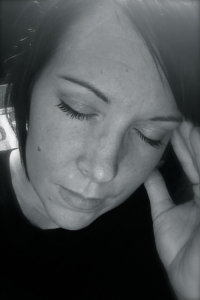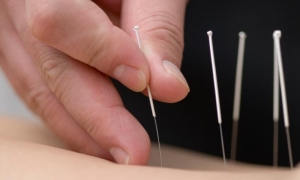If you are familiar with the pain of a headache, you are not alone in your suffering. Nine out of ten  Americans experience headaches ranging from occasional to frequent. Some headaches are dull and throbbing, and some cause debilitating pain and nausea. What is the correct response when suffering from a pounding headache? Do you grit your teeth and carry on? Lie down? Pop a pill and hope the pain goes away? Research shows that spinal manipulation, the primary form of care provided by doctors of chiropractic, may be an effective treatment option for tension headaches and headaches that originate in the neck. A report released in 2001 by researchers at the Duke University Evidence-Based Practice Center in Durham, NC, found that spinal manipulation resulted in almost immediate improvement for headaches that originate in the neck. The benefits include significantly fewer side effects and longer-lasting relief of tension-type headaches than a commonly prescribed medication.
Americans experience headaches ranging from occasional to frequent. Some headaches are dull and throbbing, and some cause debilitating pain and nausea. What is the correct response when suffering from a pounding headache? Do you grit your teeth and carry on? Lie down? Pop a pill and hope the pain goes away? Research shows that spinal manipulation, the primary form of care provided by doctors of chiropractic, may be an effective treatment option for tension headaches and headaches that originate in the neck. A report released in 2001 by researchers at the Duke University Evidence-Based Practice Center in Durham, NC, found that spinal manipulation resulted in almost immediate improvement for headaches that originate in the neck. The benefits include significantly fewer side effects and longer-lasting relief of tension-type headaches than a commonly prescribed medication.
A 1995 study in the Journal of Manipulative and Physiological Therapeutics found that spinal manipulative therapy is an effective treatment for tension headaches. It was also reported that those who ceased chiropractic treatment after four weeks experienced a sustained therapeutic benefit in contrast with those patients who received a commonly prescribed medication.
Headache Triggers
Headaches have many causes or “triggers.” These may include foods, environmental stimuli (noises, lights, stress,) and/or behaviors (insomnia, excessive exercise, blood sugar changes). But these triggers are generally not the root cause. So what is?
Posture is arguably the key driver of headaches and migraines in most sufferers. Poor sitting or standing posture creates tension in the muscles at the front of the neck; these become taut and overpower the rear neck muscles, pulling the head forward and creating “forward head carriage.” This improper position adds stress to the vertebra of the cervical and thoracic spine. Neural tension and aggravation of these nerves drives a common headache type known as tension headaches and can create long-term patterns that can lead to migraine headaches.
Cervicogenic vs. Migraine Headaches
Cervicogenic headaches begin as tension and a dull ache at the base of the neck, up the neck, and then under the occiput. These headaches usually, but not always, occur on one side, with pain at the temporal bone and behind the eye. Tension headaches are highly related to a few small muscles located at the base of your skull: The “suboccipital muscles.” When these muscles are tight, they can create referral pain in your head. Additionally, they can also put tension on a nerve that travels through the area, which causes headache pain. Typically, people with headaches have a lot of tension in their neck muscles; most of which comes from their day-to-day poor posture and sleeping habits.
Tension headaches are caused by muscular tension and contraction involving the muscles of the shoulders, neck and head. Often this tension is a result of emotional stress, though injuries can also set a pattern of muscle contraction into play. It is normal for muscles to contract when we are threatened, irritated, or angry This is a reaction known as the fight or flight response. Over time, if work or home life creates a constant source of stress from which we can neither fight nor flee, the muscular tension can become chronic. This, in turn, leads to uneven stresses on the skeletal structure of the body, and changes in normal posture and movement to compensate. These misalignments lead to more muscular tension and contraction. This can become a vicious cycle that eventually manifests as headache pain.
Migraine headaches are vascular headaches, arising from sudden dilation of the blood vessels of the head. No one knows exactly what causes migraine headaches, though the basic mechanism, involving both the nervous and vascular systems, is well studied. Migraines can be triggered by hormonal changes, foods, smells, weather changes and stress. The headaches often begin with symptoms other than pain, such as visual auras, nausea, or sensitivity to light and sound. The headache that follows can vary in intensity, but is often severe. Many migraine sufferers have found  over-the-counter pain medications to be ineffective, and resign themselves to wait out the migraine event in a dark, quiet room. A variety of pharmaceutical drugs have been developed to treat migraines, but none of them work for everyone, and many have unwanted side effects.
over-the-counter pain medications to be ineffective, and resign themselves to wait out the migraine event in a dark, quiet room. A variety of pharmaceutical drugs have been developed to treat migraines, but none of them work for everyone, and many have unwanted side effects.
Prevention and Treatment
Prevention of headaches is first, and most importantly, dependent upon improving posture. Improving the asymmetrical imbalance between the cervical musculature and the forward head carriage is imperative in long-term prevention. Many of our clients enter our practice with “forward head posture,” which is defined exactly as it sounds: The head is in a position that is too far forward with respect to the cervical spine. This is secondary to poor posture. Forward head posture causes a constant contraction of your neck muscles. Take a look at the picture above for a great visualization of all the extra weight carried around all day! This forward-head posture causes the head to be in an extended position, and thus puts pressure on the nerves that travel through the neck musculature.
For every inch forward the head is carried, it gains 10 pounds in weight! The muscles are required to work harder in order to hold the position. Another interesting finding can be studied in the journal ‘Spine.’ It was recently reported that the muscles utilized in those with forward head posture, connect to the ‘dura mater’ (the outermost membranes covering the brain and spinal cord). Therefore it is concluded that the tight suboccipital muscles can cause tension on the dura mater, and contribute to headaches. In a cadaver study, it was noted that 11 out of 13 cadavers had a connection between one of the suboccipital muscles and the spinal dura mater. A study done previous to this reported the connection is related to headaches.
What Can You Do?
If you spend a large amount of time in one fixed position, such as in front of a computer, on a sewing machine, typing, or reading, take a break and stretch every 30 minutes to one hour.
The Bruegger Stretch is one of my favorite stretches. Simply stand up tall, open your hands up as wide as you can and rotate your wrists backwards as far as possible. From this position take a deep breath and slowly blow out. Repeat the breath 2 times more. This stretch should feel comfortable and leave you with a feeling of relaxation.
Low-impact exercise may help relieve the pain associated with primary headaches. However, if you are prone to dull, throbbing headaches, avoid heavy exercise. Engage in such activities as walking and low-impact aerobics. These exercises bring blood flow to the upper torso muscles and allow for relaxation.
Wall slides can be a great exercise to improve upper body posture by stretching the tight muscles in your shoulders that create bad posture. These slides will move downward. Aim to feel a contraction under your scapula and wrapping around your ribs. Keep the elbow, wrist, and back of the hand on the wall during the slide. End the slide if one of those parts comes off of the walls or if your low back starts to extend. Stay in that range until the muscles lengthen and you can keep good posture throughout the motion.
Strength training exercises that build-up the muscles between the shoulder blades can be helpful in improving the poor posture that creates headaches. Rowing exercises can be the most helpful. Using a dumbbell, pulley machines, and/or resistance bands, can be the best tools for strengthening these important muscles. Push-ups and pull-ups are two other exercises that have been shown to improve quality of life for headache sufferers.
 If you need more exercises, check out our YouTube video of 5 Exercises for Head, Neck, and Shoulder pain, https://www.youtube.com/watch?v=ykcX47PhBS4
If you need more exercises, check out our YouTube video of 5 Exercises for Head, Neck, and Shoulder pain, https://www.youtube.com/watch?v=ykcX47PhBS4
Chiropractic and Migraine Headaches
Chiropractic care can play an important role in treating migraines. Clinical studies, though still preliminary, suggest that chiropractic may have a measurable role in the prevention of migraines. Through manipulation and adjustments of the spine and neck, migraines can often be reduced or prevented. Nerves control vascular system tension, and chiropractic adjustments reduce irritation of the nervous system beginning with its roots in the spine, also improving vascular flow. Chiropractic adjustments, combined with other therapies such as trigger point therapy, can release muscular tension and realign the skeleton to break the cycle of pain. Often patients with chronic headaches will find relief through chiropractic in just a few treatments, as muscles relax and nerve irritation is reduced.
Migraine and Headache Sufferers, Acupuncture Can Help!
The pain that headache and migraine sufferers endure can impact every aspect of their lives. Acupuncture can offer powerful relief without the side effects that prescription and over-the-counter drugs can cause. Acupuncture has been used to relieve headaches, as well as their underlying causes for thousands of years and is a widely accepted form of treatment for headaches in our society.
The Acupuncture Treatment: Acupuncture “points” that treat headaches are located all over the body. During the acupuncture treatment, tiny needles will be placed along your legs, arms, shoulders, and perhaps even your big toe!
There seems to be little sensitivity to the insertion of acupuncture needles. They are so thin that several acupuncture needles can fit into the middle of a hypodermic needle. Occasionally, there is a brief moment of discomfort as the needle penetrates the skin, but once the needles are in place, most people relax and even fall asleep for the duration of the treatment.
The length, number, and frequency of treatments will vary. Typical treatments last from five to 30 minutes, with the patient being treated one or two times a week. Some symptoms are relieved after the first treatment, while more severe or chronic ailments often require multiple treatments.
In a study published in the November 1999 issue of Cephalalgia, scientists evaluated the effectiveness of acupuncture in the treatment of migraines and recurrent headaches by systematically reviewing 22 randomized controlled trials. A total of 1,042 patients were examined. It was found that headache and migraine sufferers experienced significantly more relief from acupuncture than patients who were administered “sham” acupuncture.
Most likely there is not one thing that will fix your headaches. A comprehensive approach to treatment and prevention of your headaches is your best bet to reducing or resolving your symptoms. Talk to Dr. Rich about what steps you can take to have a happier, healthier, and headache free 2016! Call our Roanoke, Virginia office to find out how we can help you on your path to a healthy new you. 1-540-344-1055.

Dr. Daryl Rich, DC, CSCS






